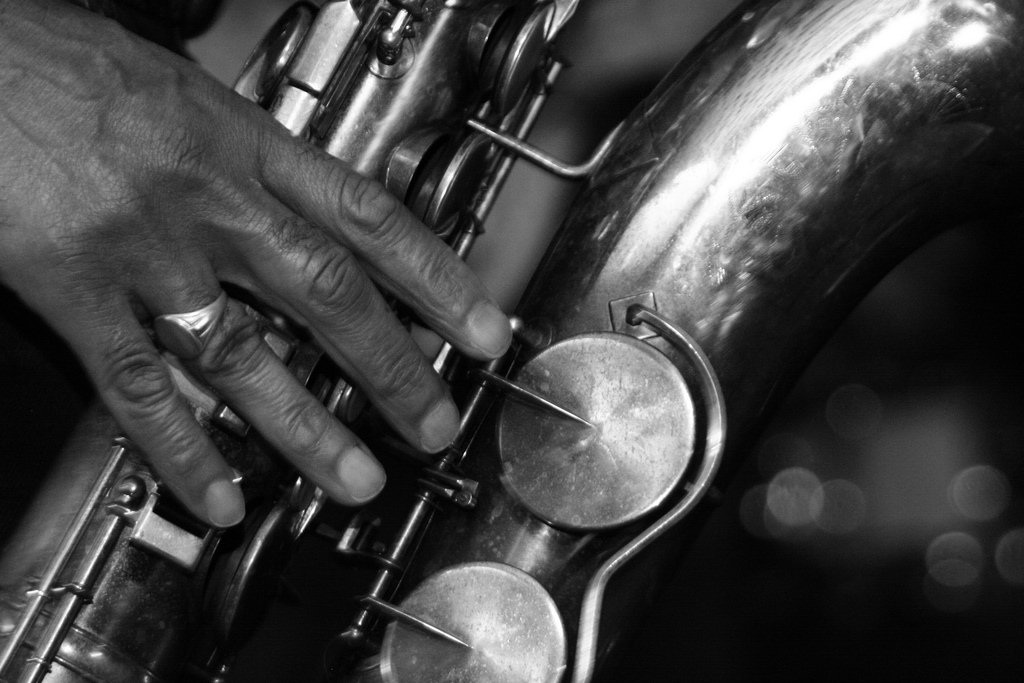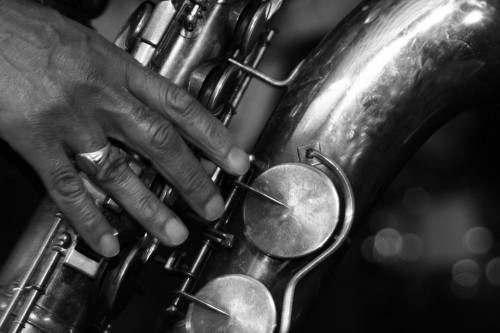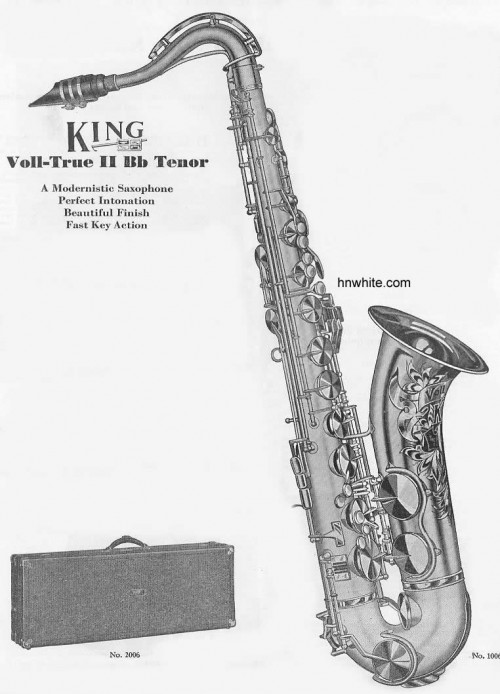When I saw this interesting photo of blues saxophonist Fred Tipton on Flickr, I was instantly drawn to the eyebrow key guards. It was either a Hohner President or a King Zephyr—or so I thought.
I then looked at the shape of the right pinkie keys, and was immediately confused. I knew it wasn’t a Hohner, so it must be a King. I just couldn’t remember seeing squared off keys like this on a King however.
Fred’s Fingers
Photography by: wmshc_kiwi Source: Flickr
After a quick visit to the h.n.white.com website, I soon realized that the eyebrow key guards that are so commonly associated with the Zephyr, were also found on the Voll-True II. This model, along with its replacement—the first generation of Zephyrs—had the squared off right pinkie keys.
Source: h.n.white.com
Source: h.n.white.com
So Fred’s King is indeed a very vintage sax. The Voll-True II tenors were first introduced circa 1933-34.
If on the other hand Fred’s sax is a Zephyr, it might have been made as early as 1936-37. That was when the Zephs were first introduced as the Voll-True II’s replacements.
A bit of further sleuthing on Flickr uncovered a photo of the whole horn. The neck guard is that of a Voll-True II.
Now here’s a question for you to ponder: Do you think that the pro model saxes—at least that’s what they’re being marketed as—that people buy today for around a thousand bucks, are going to be able to be used as gigging horns in 74 years?







I happened across this late model, post-H.N. White Silver Sonic Super 20 tenor on eBay this morning. Check out its neck. I’m wondering if our Fred here might have replaced his neck with one of these?
What about Fred’s neck? Original? Looks like a SML/King neck to me?!?!?!
The neck of Freds saxophone!!!!
Mmm, not Fred’s neck? Really? :scratch: 😆
Here’s a shot of the “wishbone” front of my Zephyr’s neck.
My Zeph’s neck looks a bit different because of the cuff. The horn has a double socket neck.
The profile looks like a King neck to me. The “wishbone” front and
the octave vent coverappear the same. The thing that is a bit difficult to make out from the ad that I found on the h.n.white website is the shape of the neck guard. Is it made of round metal like on the Martin Handcraft? Or is it more rectangular, as it appears to be in the photograph of Fred?Edit: Upon looking at the 2 images some more, I retract my octave vent cover appearing the same comment.
> Now here’s a question for you to ponder: Do you think that the pro model saxes—at least that’s what they’re being marketed as—that people buy today for around a thousand bucks, are going to be able to be used as gigging horns in 74 years?
Well, a base model Conn New Wonder alto in polished brass was $85, sans case, in 1922 dollars. That’s $1079 in 2009 dollars. Buffet sells their base 400 model alto (which is Chinese made) for about the same price, but I think that there isn’t a dealer that’s marketing a horn as “pro” that’s got a cheaper price.
Considering that there are still LOTS of Conn New Wonders around after 80+ years, the question can be modified to, “Is a Buffet 400 as durable as a Conn New Wonder?” My answer: I doubt it. Is a Buffet 400 better than a Conn New Wonder? That’s probably a better question :).
Oh you would want to stir the pot wouldn’t you? 😈
Seriously though, I see your point, and then we get into the splitting of subjective hairs. “Better”. Ergonomically? Sonically? Etc. Etc. The camps then divide along the lines of vintage vs modern horn players/lovers.
Yes, yes I do. :O)
Me thinks you have your tongue firmly planted in your cheek. Or, perhaps I’m mistaken. In which case, can I interest you in some swamp land in Florida?